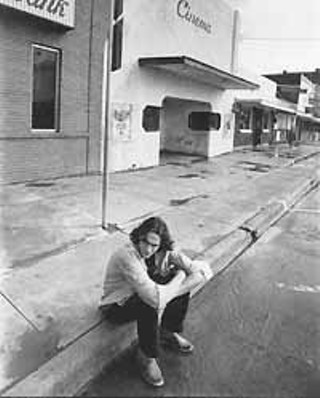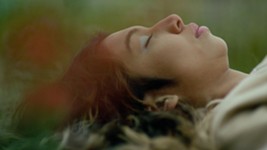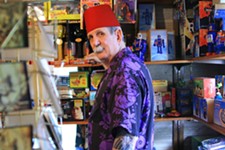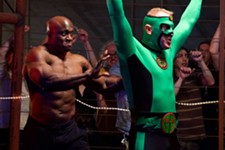Cars and Speed and Flight
The Continuing Career of Director Monte Hellman
By Marc Savlov, Fri., March 10, 2000

Outside of film circles, the name Monte Hellman is more likely to draw blank stares than the effusive praise it deserves -- but that's hardly Hellman's fault. He's big in France, a sure sign that he's probably much better than the current American movie-going public deserves, though he's been saddled with the "American auteur" appellation since his almost-breakthrough -- Two-Lane Blacktop -- skidded to a nonexistent box office 29 years ago. As the film at the heart of SXSW Film 2000's Monte Hellman retrospective, Two-Lane Blacktop was feted as the only worthy successor to Dennis Hopper's Easy Rider when it came out in 1971. Since then, it's reached legendary status, the kind of mythic superfilm that fired Terrence Malick's early career. Indeed, both Malick and Hellman work the same existential angst into their films, mixing the mundane (cars, cowboys, killers) with a not-so-nouvelle vague mindset that plays off the American id like so much buckshot off bone. Two-Lane Blacktop, starring a young James Taylor, Beach Boy drummer Dennis Wilson, and Hellman regular Warren Oates, is about cars and speed, but Hellman being the auteur that he is, it's also about a lot more than that. With an unerring eye, Hellman paints a vivid, throbbing, 400-cc. picture of the dying American dream. Cars and speed and flight. The movie fairly rockets out at you, all dark and wet and dangerous.
Two-Lane Blacktop was the director's eighth film. Before that, he worked in the genius-rich fields of Roger Corman's films for American International Pictures, from low-grade shocker The Beast From the Haunted Cave in 1959 to Corman's Karloff-on-a-cliff epic The Terror in 1963 (in which Hellman was only one of five directors). A passing friendship with another Corman regular -- Jack Nicholson -- led to a professional relationship spanning several films, including 1967's existential Western The Shooting.
Hellman continued to work with Nicholson throughout the Sixties, but it was his relationship with actor Warren Oates that brings to mind the Scorsese/De Niro comparisons. Oates starred in four Hellman films (and one of Malick's as well) before passing away in 1982. His weathered face was a perfect physical expression of the interior lives of the characters he played, from the cuckolded frontier husband of China 9, Liberty 37 to the brooding enigma of Cockfighter's Frank Mansfield. Maybe Hellman had been looking for an anti-leading man, or perhaps he had simply lucked out; either way, the films were the winners.
Since the early Eighties, Hellman has kept busy with a series of films that some directors might have balked at -- the Spanish-lensed Iguana, the third sequel in the Silent Night, Deadly Night horror series -- but by his own account, he's never stopped making films. In 1992, he was approached to direct a script by a then-unknown Los Angeles upstart named Quentin Tarantino. The script was Reservoir Dogs, and a twist of fate kept Hellman's name in the producer's slot as opposed to the director's -- but Hellman is still jazzed about being there at the birth of QT's career.
I spoke with Hellman about his career, where it's been, and where exactly it's going (you'll be surprised) -- at 68 years, you kind of feel this guy's just warming up ...
Austin Chronicle: You got your start back in the late Fifties-early Sixties with Roger Corman, alongside people like Peter Bogdanovich, Jonathan Demme, Martin Scorsese, Francis Ford Coppola, and Jack Hill. Can you give me an idea what that was like, and how you came to be involved?
Monte Hellman: I was producing and directing in the theatre in Los Angeles, and Roger was one of the investors in the theatre I was at. We got evicted, as it happened, when they decided to tear the theatre down and turn it into a movie theatre. Roger made a comment that I should look at that as the handwriting on the wall, so to speak, and take it as a sign to start working in films, and he offered me a movie.
AC: How do you view those early works looking back today?
MH: Well, I'm embarrassed by The Beast From Haunted Cave just because when I see it I just see my total, ah, ignorance at the time and just a lack of knowledge of the medium. So that's an embarrassment, but not because of the kind of picture it was or the situation with Corman but just because of my own lack of experience. I think very fondly of the days on The Terror and a whole series of other pictures that I did pieces of -- that experience was terrific because I really had my own unit and I was able to produce, write, and direct some stuff that I thought was very creative. And it was a great learning experience.
AC: What were those "pieces" of films you did?
MH: Oh, there was a whole series. I actually added some scenes to Beast From Haunted Cave as well as Last Woman on Earth, Creature From the Haunted Sea (which was a remake of Beast From the Haunted Cave), and Ski Troop Attack.
AC: Beginning with The Wild Ride (1960) you began a working relationship with Jack Nicholson which continued for some time. How did that come about?
MH: We became friends on The Wild Ride, and we ended up writing a script together which Corman was supposed to produce but he ended up changing his mind and instead offered us the chance to do a pair of Westerns in Utah [Ride in the Whirlwind, 1965; The Shooting, 1967].

AC: Were the Westerns that you did in the mid-Sixties something you were eager to do or were they more something you were saddled with?
MH: Well, we didn't ask to do the two Westerns -- that was Corman's idea -- but it happened to be something that I was very fond of. I was a big fan of Westerns all through my formative years, and I was a great fan of The Lone Ranger serials when I was growing up.
AC: Those early Corman years were an amazingly fruitful time for so many young filmmakers who are now some of the most respected and influential artists of our time. What was it about Roger Corman that drew so many young maverick directors to him?
MH: Well, I think it wasn't just directors. Roger was (and is) an extremely bright guy, he's a Rhodes scholar, he was an engineering student at Stanford University, he's just absolutely one of the brightest people I've known in my life. Like a lot of bright people -- not all, but a lot of bright people -- he wanted to surround himself with other bright people. Roger wouldn't even consider anybody for his personal assistant or secretary unless they had a Phi Beta Kappa key. He had these kind of prejudices in favor of intelligence, and so he hired a lot of bright people to work for him in every department including filmmakers.
AC: Was it ever intimidating working under the time and budget constraints that Corman is known for?
MH: Not intimidating, but it was a challenge. I enjoy that kind of challenge. I kind of did my training in summer stock, and that was far more harrowing an experience than anything I ever did with Corman.
AC: To this day, Two-Lane Blacktop is the film you're best known for, and rightly so. That said, the film pretty much sank without a trace when it was released in the summer of 1971 despite having been nominated "Film of the Year" by Esquire magazine, which also ran a cover story in their April issue. What happened?
MH: It was very simple. The sales department at Universal was very enthusiastic, and they thought they had something they could really sell. I think they had it in more theatres than any other picture in Universal's group of films for the year. There was just a tremendous kind of advance hype on it. What happened was that Lou Wasserman, who was then head of the studio, saw the picture and literally hated it. He just was offended by it. I don't know whether it was just his personal taste or whether it was that this whole group of pictures that Two-Lane Blacktop was part of --
AC: What group was that?
MH: There was a group of five pictures that one of the Universal executives at the time had under his wing to produce. There was a Milos Foreman picture, a Frank Perry picture, there was a Dennis Hopper picture, and I think Peter Fonda had one of them, too. What had happened was that Wasserman had agreed to produce these pictures through Universal but really didn't believe in them and really wanted to kill the whole program. And so he didn't promote any of the pictures and in particular Two-Lane Blacktop. It opened in New York City on July Fourth weekend without one single newspaper ad. People didn't even know it was playing. The excuse was that it was Fourth of July weekend and nobody would be in town, so what's the point in advertising? But then if nobody's going to be in town, then why open the picture?
AC: It's not your standard summertime guys-and-cars film, either. It's a very stark, lyrically macho, combative kind of thing that's going on in the film, between Dennis Wilson and James Taylor and Warren Oates, you know? Like a postmodern Western of sorts. It's not American Grafitti. How much of that verbal and emotional taciturnity came packaged in the script [by Will Corry, later by Rudy Wurlitzer] and how much of it came from you?
MH: The script that I was given bears no resemblance to the movie. Rudy Wurlitzer had not yet been involved -- it was a Will Corry script that had been bought by, not Universal but by another studio, for producer Michael Laughlin. He asked me to direct it, and I said that I would, because I liked the basic idea of it, but I said I would only do it if I could hire somebody else to do a new screenplay. And he agreed and we found Rudy, and I worked alongside him while he was developing the script. It was exactly the movie that I wanted to make, and I was really excited to be working on it.
AC: How did you select James Taylor and Dennis Wilson, a pair of musicians, for the two leads?
MH: I saw James' picture on a billboard on the Sunset Strip and asked to have him come in and do a screen test. Dennis Wilson was the last actor to be cast and we saw just, you know, hundreds of people before him.

AC: What was it about Wilson that caught your eye?
MH: I think just that he had lived that role, that he really grew up with cars. It was almost as though he were born with a greasy rag in his back pocket.
AC: How much of an influence did the Sixties have on your directorial style? So many of your films -- from Two-Lane Blacktop to the spaghetti Western of China 9, Liberty 37 to the so-called "existential" Westerns you did with Nicholson early on -- seem to be saturated in that sort of rebel ideal that we've come to identify with that decade. Was that always in you or was it a sign of the times?
MH: I think my formative years as a director really were the Fifties. Maybe somewhat into the Sixties, but I think I was very influenced by the films that I saw in [the Fifties] such as A Place in the Sun and by directors such as George Stevens, John Huston, Carol Reed, and by some of the New Wave and some of the Italian directors of the early Sixties.
AC: Warren Oates was a Hellman regular up until his death in 1982. How did that relationship come about?
MH: I had seen him in a production of Cuckoo's Nest at the Player's Ring Theater in Los Angeles, and he was also a friend of Nicholson's. I think it was remembering him from Cuckoo's Nest that made me think of him for The Shooting, which was the first time we worked together. I remember there was a book store in Beverly Hills called Martindales and I was in there one day and -- sometimes I just get "flashes" -- and I got a flash of Millie Perkins and Warren Oates and Will Hutchins. I thought of all three of them in one flash, they didn't just come to me one at a time. I was so excited that I ran out of the bookstore and called Jack to tell him my idea and he called Warren.
AC: Do you have a personal favorite amongst your films?
MH: I think it's always the one I'm about to do.
AC: And what are you about to do?
MH: I'm about to do a picture called The Pay Off. That's going to be done in Austin and should be shooting in August. It's a romantic adventure thriller in the manner of The Getaway.
AC: How did you become involved in producing Reservoir Dogs?
MH: The script had been sent to me with the idea that I might be interested in directing it, and I was. I was very excited about it. A meeting was set up between me and Tarantino and the day we met he had sold the script of True Romance and he decided that he had the ability to hold out to direct Reservoir Dogs himself. He said he admired me and admired my work, but he hoped I would understand, and I did. I was so impressed with him, and he just oozed this kind of authority that I said I thought he'd probably do a terrific job, and if there's anything I can do to help, I would. And so I did.
AC: What's the most important thing about being a director to you? If you could sum it all up at the end of the day, what's it all about?
MH: [laughing] Oh god. That's like saying "Why do you live?" I've been in love with the movies as long as I can remember. I went to see my first movie when I was four years old -- I wish I could remember what it was -- but, you know, I've always lived in this dream world that's been stimulated by this wonderful medium and I think it's a tremendous privilege to be able to play with it, and to experience it, and to add my own manufactured dreams to the others that I've been living with right along. ![]()
The Monte Hellman Retrospective is co-sponsored by the Austin Film Society.
"To Be or Wannabe: 25 Prints by Monte Hellman" is an exhibition on display at Pro-Jex Gallery, 1705 Guadalupe, through March 30. The exhibit is co-sponsored by the Austin Film Society and SXSW.










